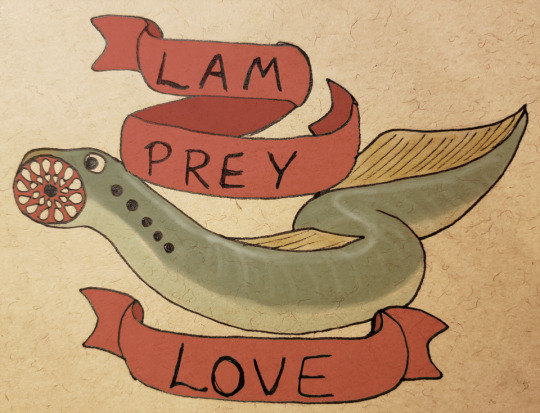#agnathan
Text
Wet Beast Wednesday: hagfish
After taking last week off for mental exhaustion I have returned! And what better way to mark my return than with a shitload (or perhaps a highway load) of slime? Today I'm returning to the agnathan trenches to dredge up one of two living groups of jawless fish. I covered lampreys before, so now it's hagfish time. These ooey gooey critters are both fascinating and kinda gross. Now get ready, because it's time for slime.

(Image: a hagfish in profile. It is a long, brown, eel-like animal with a fin encircling the tail and a small head with no visible eyes or mouth. End ID)
Hagfish, also known as slime eels, are approximately 76 members of the class Myxini. In addition to the living species, hagfish have been preserved in the fossil record, letting us track their evolution through history. Hagfish are one of two living groups of agnathans, commonly known as jawless fish, with the other being the lampreys. As the name suggests, jawless fish are vertebrates without hinged jaws. Way back when bones were the cool new thing in town, agnathans represented the entirety of the vertebrates and were extremely diverse, but the evolution of jawed fish resulted in them getting largely outcompeted, leading to all lineages but the hagfish and lampreys going extinct. Genetic studies indicate that hagfish and lampreys are more closely related to each other than either group is to any other vertebrate. Because they are the only jawless fish left, hagfish and lampreys are of interest to scientists studying the evolution of vertebrates.

(Image: a hagfish coiled up, under orange light. The head is visible, featuring small sensory barbels and a large hole that resembles a mouth but is actually the nostril. End ID)
Hagfish are eel-shaped animals that range in length from a few centimeters to over a meter in the largest species, Eptatretus goliath. They have no scales, flattened tails that bear the only fin, and simple, eyeless heads. The heads bear sensory barbels, a single nostril, and the mouth. The mouth has two pairs of rasping plates that normally sit within the mouth, but can be everted to face outwards. The plates can grab food and pull it into the mouth to be swallowed. Hagfish do not have true eyes, but they do have eyespots that can sense light and dark. Interestingly, their fossil ancestors did appear to have fully-developed eyes that reduced in complexity until the present state. Likewise, ancestral hagfish had a true vertebral column made of cartilage, but modern hagfish only have remnants of their ancestor's vertebrae. Hagfish skin is very loosely connected to the internal body, only attached along the spine and slime glands. This makes the skin very flexible and harder for predators to grab. A third of the blood is contained between the skin and body and is pumped around with the heart as well as a few additional pumps that act as auxiliary hearts. Hagfish have some of the lowest blood pressure of any vertebrate and the highest blood volume to body mass ration of any chordate. Hagfish are also the only vertebrates that do not osmoregulate, meaning they cannot regulate the amount of salt in their bodies. Changes in salinity, especially moving to a lower salinity environment, are very dangerous to hagfish. Hagfish skeletons barely qualify, consisting of only a skull, notochord, and fin rays, all made of cartilage. The gills are internal. Water enters through the mouth and is forced over 5-16 internal gill pouches, then ejected through pores in the side of the body.

(Image: a closeup of a hagfish head with the rasping plates everted. The plates are mounted on pink tissue around the pharynx. there are two plates on either side of the pharyx which look like rows of small, sharp teeth. End ID)
That's all well and good, but you're here because of the slime. The hagfish's main defense is to create lots and lots of slippery slime. The slime helps them slip away from predators. If a fish tries to eat a hagfish, the slime can clog up its gills, forcing the fish to either release the hagfish or suffocate. A common factoid is that a single hagfish can turn a 5-gallon bucket of water into slime in seconds. To produce the slime, the hagfish releases threads made of special proteins into the water from glands on its skin. These proteins react with seawater to create a matrix of trapped water held together by filaments similar to keratin. The slime matrix can expand 10,000 times its original size in 0.4 seconds of exposure to seawater. The slime is quite durable and resistant to breaking and dissolving in water. After sliming, hagfish have been seen wrapping their bodies into an overhand knot and running themselves through the loop to scrape the slime off of themselves. Its possible that the slime also impairs the hagfish's ability to use it's gills and it needs to do the know to get the slime off and breathe again.

(Image: a person reaching into a holding tank full of hagfish and pulling out an armload of thick, viscous, white slime. End ID)
youtube
(Video: a hagfish in the wild demonstrating its knotting behavior. This one is going in the opposite direction usually seen: tail-to-head instead of head-to-tail. End ID)
Hagfish are found in most of the oceans, with range varying based on species. They are benthic animals that rarely swim far above the seafloor. Some species dig burrows to shelter in while others will shelter under rocks and other structures to avoid predators. While lying on the sediment, some hagfish species will coil up while others will lie straight. Hagfish are carnivorous and feed with a combination of hunting and scavenging. A large portion of the hagfish diet consists of polychaete worms and other known prey species include small crustaceans and echinoderms. Some species have been known to hunt burrowing fish, possibly by clogging up the burrows with slime to suffocate the prey. If you've seen a documentary about deep-sea fish you probably know about hagfish scavenging. Using their large nostril and sensitive sense of smell, hagfish can sense carcasses from long distances and are often some of the first scavengers to arrive at a new body. They use their rasping plates to pull bits of meat off of the carcass. A similar behavior to the slime-cleaning knots is seen when scavenging, but in reverse, going from tail to head instead of the other way around. This grants the hagfish additional mechanical advantage, allowing it to rip off larger chunks of food. Hagfish will burrow into larger corpses, possibly to get access to a food source with less competition than the outside of the body. Hagfish act as part of the deep ocean's cleaning crew, consuming corpses before they can decay and release potentially harmful chemicals into the water or act as sources of disease. Unlike any other living chordate, the food a hagfish swallows is encased in a permeable membrane during digestion. Hagfish can also absorbed dissolved nutrients through their skin. Hagfish have a very slow metabolism and ones in captivity have been observed going for up to 7 months between meals.
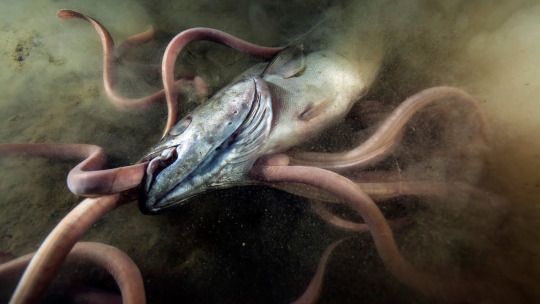
(Image: several hagfish feeing on the body of a fish. The hagfish have their heads on the fish's body and one hagfish is entering the fish's mouth. End ID)
Hagfish reproduction is still something of an enigma as so many of them live in the deep sea, making it difficult to observe them reproducing. It has been observed that females seem to outnumber males, with the exact ration varying depending on species. In some species, the sex ratio is almost even, while in others, there are 7 females to each male. however, it should be noted that females mature sexually faster than males and it has been suggested that this is responsible for the apparent skewed ratio. Hagfish eggs have tufts at the end that cause them to get stuck to each other like velcro. It has been suggested that eggs are laid in clusters possibly in burrows, beneath rocks, or protected with slime. Some species seem to have a mating season and seasonally migrate. Hagfish have only a single ovary or testicle (the latter of which has been described as unusually small by scientists and bullies in the deep-sea locker room) and they have no specialized reproductive tract. Instead, gametes are released into the main body cavity and must find their way to the anus to leave the body. Hagfish embryology is poorly understood, though it has been reported from studies of Eptatretus stoutii (Pacific hagfish) that the eggs can take up to 11 months to hatch. Hagfish have no larval stage, unlike lampreys and bony fish.

(Image: a group of 9 hagfish eggs in a plastic tub. The eggs are ovoid and dark yellow, with tufts of fibers at each end. End ID)
The conservation status and needs of most hagfish species is hard to discern because of the depths they inhabit. Threats to them include bycatch, as hagfish are often caught during deep-sea dredges. It is alos possible the chemical pollutants may be passed to hagfish through scavenging. There is a commercial fishery for hagfish, which is largest off of the west coast of the Americas. Hagfish are eaten as a delicacy in Korea and less commonly eaten in Japan. Most of the hagfish fishery goes to Korean food markets. Hagfish skin is also values as a durable leather and often marketed as "eel leather" or "yuppie skin". Study of the slime and the highly durable threads that produce it indicates they could be used to create very strong materials, similarly to spider silk. Research is currently being undertaken to find uses for hagfish slime and threads.

Once again, these cards show up in my posts (Image the Weird n' Wild Creatures card for hagfish, featuring an exaggerated drawing on a hagfish. End ID)
#wet beast wednesday#hagfish#agnathan#jawless fish#slime#deep sea fish#fishblr#fish#marine biology#biology#zoology#ecology#informative#educational#image described#cw animal death#Youtube
132 notes
·
View notes
Text
Throwback!! To my first ever attempt at paleo art! I've certainly come a long way since 2021, but I decided to start off with my favorite agnathan, Cephalaspis!
35 notes
·
View notes
Text
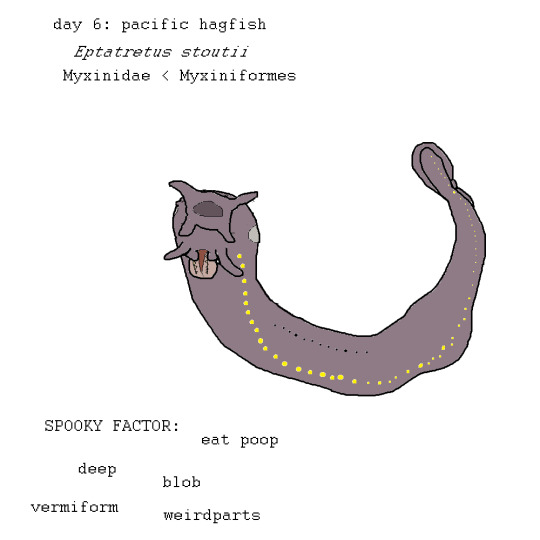
#eptatretus stoutii#eptatretus#hagfish#pacific hagfish#slime eel#agnathan#jawless fish#october#mspaint#myxinidae#myxiniformes
0 notes
Text
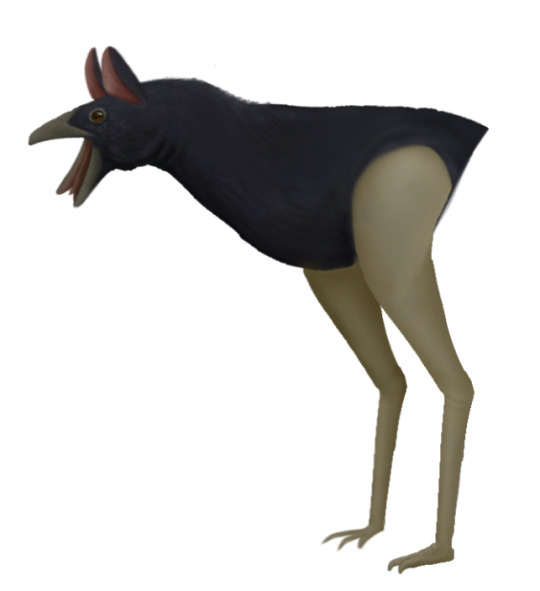
the Furbilloidea, commonly known as ‘furbs’ or ‘furbies’, are among one of the most versatile groups of tatzels - furred varms. Furbilloids can range in ecological roles from swift carnivores to stout, hamster-like omnivores to nektonic, duck-like herbivores. Here pictured is a familiar benbuksen (Benbuksen phasianoides familiaris), a swift and speedy omnivore domesticated as a means of driving away potential varmint and as a means of hauling goods.
#ibispaint#art#fantasy#furby#spec biology#may provide context later#they are not birds or some weird alien species but rather terrestrial agnathans
2 notes
·
View notes
Note
What would be the first thing you do if you evolved back into a fish?
easy. eat other fish.
2 notes
·
View notes
Text
Podcast episode 9 is OUT!
🇮🇹 L'episodio 9 è finalmente online! Parleremo di stagni, anfibi, pino silvestre, sistema nervoso e molto altro! Come sempre, una condivisione è più che benvoluta. Trova la tua piattaforma di ascolto sul nostro linktree.
🇪🇸 ¡El episodio 9 está finalmente en línea! Hablaremos de estanques, anfibios, pino silvestre, sistema nervioso y mucho más. Como siempre, una compartición es más que bienvenida. Encuentra tu plataforma de escucha en nuestro linktree.
🇬🇧 Episode 9 is finally online! We will talk about ponds, amphibians, Scots pine, the nervous system, and much more! As always, sharing is more than welcome. You can find your listening platform on our linktree.
#drops of science#science#podcast#sperm whales#Physeter macrocephalus#social mammals#communication#codas#cetaceans#Caribbean#phonetic alphabet#evolution#nervous system#agnathans#jawless vertebrates#lampreys#Petromyzon marinus#sympathetic ganglia#sympathetic neurons#neural crest#neurons#vertebrates#conservation#artificial ponds#ecological restoration#aquatic biodiversity#connectivity#amphibians#Scots pine#Norwegian spruce
1 note
·
View note
Note
Top ten imaginary fishes?
I want there to be a freshwater swamp shark again like there was in prehistoric times, there were these long skinny eel shape ones and stuff, one like those
pelican eel but it isn't limited to the abyss, I wanna be able to see a pelican eel at the regular beach
a modern dunkleosteus species but only like 3 feet long, not big enough to kill people just big enough to completely bite hands off
a filter feeding coelecanth species the size of a whale shark
a freshwater agnathan I invented that's like a short fat googly eyed hagfish and bites like a cookie cutter shark, living in muddy rivers. I just want this to exist because they'd be horrible and everyone would dislike them but I'd keep one as a pet and love him.
Mudskipper but it's as big as an alligator and can eat a person
Dragon moray but it's 10 meters long
freshwater walking batfish and it's as big as a person
a flatfish (especially if it's like a tongue sole, they're the best kind) that does the mudskipper thing and crawls around on shore more than it swims.
a parasitic bloodsucking seahorse that will bite people. Just like my vampire butterfly idea, everyone thinks seahorses are just cute and nice so I want there to be one that's more of an ass hole
I feel that too many people are unreasonably scared of the water so I want to make it reasonable for everyone to be.
1K notes
·
View notes
Text
something i think a lot of people miss because its name is EELektross but the tynamo line is in very large part based on lampreys.
lampreys are incredibly basal (resembling the ancestral form, "primitive") vertebrates- agnathans (non-jawed) are a group of fishes that include the lampreys and the hagfish, which split off from the rest of the fish we know before moving jaws existed. they can give us a good idea of what some of the earliest vertebrates kind of looked like! they have one big sucker mouth, just like eelektrik and eelektross! (all photos via wikipedia unless otherwise mentioned)


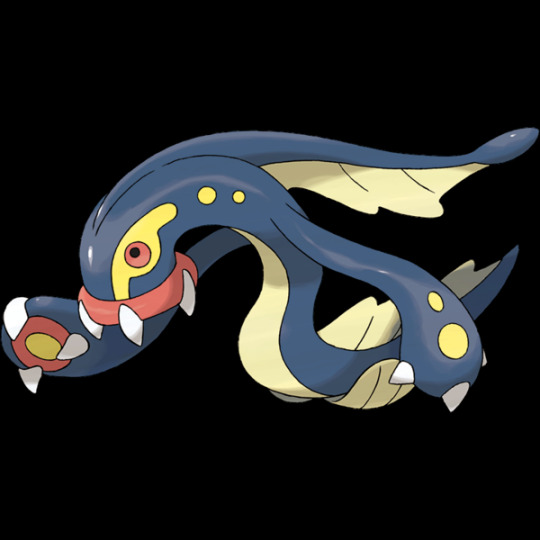
also very of note are the dots down the side of the head on both of these- they're lamprey gill slits! unlike the operculum of most bony fishes or the multiple tall gill slits of the cartilaginous fishes, lamprey gill slits are largely circular.
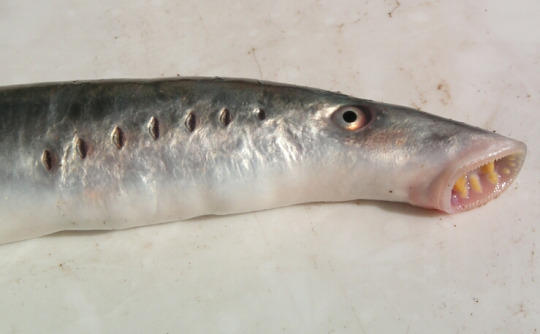
now, tynamo i'm a bit split on whether it more closely resembles eel larvae (leptocephalus) or lamprey larvae (ammocoetes).
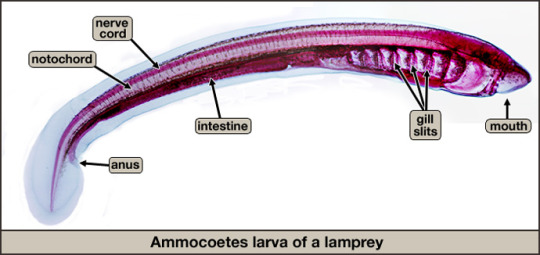
(photo via brian mccauley)

in case you didn't know, fish have larval stages! they're tiny and often weird and transparent looking. both ammoecoetes and leptocephali feed on tiny particles floating through the water (suspension feeding). i think with their white color and transparentish look, tynamo more resemble the leptocephali, but obviously with an ammocoete's jawless always-open mouth.

not relevant for our lamprey/eel discussion, but this is the larval form of the giant ocean sunfish, aka the mola mola. fucking look at it
also, a note! in addition to lampreys, the line obviously is a play on electric eels.
electric eels............are not eels.
eels are everything within the group anguilliformes. they're a big diverse group of mostly long and snake-looking fishes. this is an african conger, it's one of the prettiest eels in my opinion.

electric eels, despite the name, are indeed not eels. they're part of the gymnotiformes instead, the south american knife fish. all members of this group use electricty as a sense- they use weak electric fields kind of like an analogue to a bat's echolocation, to navigate and find food. only one genus within this group, Electrophorus, can actually shock stuff. the three species within that genus are the electric eels!
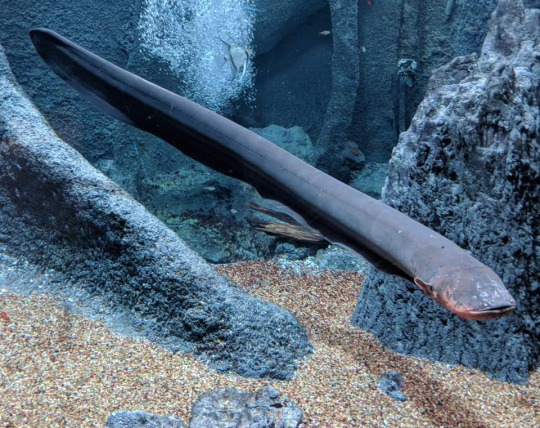
(photo via use ungulatenerd92 on zoochat)
they're funny looking guys. anyways, uh, pokemon or whatever
337 notes
·
View notes
Text
FUN FACTS ABOUT SEA BUNNIES AND FUN FACTS ABOUT LAMPREYS!
FUN FACTS ABOUT SEA BUNNIES!
- Sea bunnies are so small one will fit on your fingertip.
- Predators stay away from these little slugs because they're very toxic.
- They cleverly absorb toxins from the creatures they feed on, like toxic sponges.
- They can also steal the stingers out of jellyfish and use them against predators.
== == == == == ==
FUN FACTS ABOUT LAMPREYS!
- They're jawless.
- They die after reproduction.
- They don't have scales or gill covers.
- They don't have shells, but their ancestors, the Agnathans do!
- They don't have paired appendages.
- They don't have bones. They're just flimsy.
- They technically can't swim.
- They have poor eyesight.
- They use their suction skills to travel.
- They have a keen sense of smell.
- They can occupy both freshwater and sea/saltwater.
- They're regicidal.
- They're popular with Romans.
- They survived 3 ice ages and 5 mass extinctions.
== == == == == ==
Reason for posting these fun facts? I’m making a Cookie Run OC!
I’m tied between making a Sea Bunny Cookie and a Lamprey Cookie, which do you guys think is your pick?
9 notes
·
View notes
Text



Anglaspis
(size: 9 cm / 3.5 "; temporal range: 425-395 mio. years ago)
[text from the Wikipedia article, see also link above]
Anglaspis is an extinct genus of cyathaspidiform heterostracan agnathan. Fossils are found in marine strata of Europe, from the late Silurian period until the genus' extinction during the Early Devonian. As with other cyathaspidiforms, individuals of Anglaspis had dorsal and ventral plates covering the forebody, gill pouches, and nasal openings that lay on the roof of the oral cavity.[1]
Late Silurian species of Anglaspis are found in marine strata of Wales and England, while most of the Early Devonian species are found in the Devonian-aged strata of Spitsbergen island, in Svalbard, Norway.
6 notes
·
View notes
Text
Wet Beast Wednesday: lampreys
Welcome to the first Wet Beast Wednesday covering an agnathan. What is that, you may ask? Why it means jawless fish. But they aren't really fish even though they live underwater and have gills. Taxonomy strikes again. Anyway, agnathans are more closely related to each other than to any bony or cartilaginous fish and they may represent an early stage in the evolution of vertebrates. There are only two living groups of agnathans: the hagfish (which I'll get to sometime) and the lampreys.

(Image: a pair of lampreys, one resting on rocky sediment and one swimming. They are long, green, slender fish-like animals with only dorsal and tail fins, several holes on the sides of the heads, large eyes, and no visible jaws. End ID)
Lampreys are sometimes mistakenly called eels due to their long and slender bodies. All 38 known species are elongated, scaleless animals with a funnel-shaped, jawless mouth called the buccal tunnel or buccal cavity. They do not have paired fins, only two dorsal fins and a tail fin. The head has one nostril on the top and seven pores on each side that allow water flowing over the gills to exit the body, similar to the gill slits of sharks. Adult lampreys have well-developed eyes while the larvae have weak eyes covered with skin. In addition, they have two simple parietal eyes, making lampreys the only four-eyes vertebrates. The mouth acts like a suction cup and is used to suction onto rocks or other animals. Inside the mouth is a rasping tongue that is used to scrape at food. You may think that all lampreys are parasites that feed on blood. This isn't the case, only 18 species are predatory and some of those are thought to be exclusively scavengers. The rest of the species either feed on algae by scraping it from rocks or never eat as adults, subsisting entirely on energy stores gained as a larva. The last common ancestor of all living lampreys (which is estimated to have either lived during the Jurassic or Cretaceous periods) is believed to have fed on blood as an adult. Lampreys are believed to be part of a sister group to all jawed vertebrates and are considered the most basal (closest to the ancestral form) of all vertebrates. They have cartilaginous skeletons and primitive, cartilaginous structures called arcualia instead of vertebrae. Lampreys are some of the most efficient swimmers and swim using a different method to other fish. Instead of using their fins to push themselves forward, lampreys use their fins to generate low-pressure zones in the water around their bodies to pull themselves forward. The pressure equalizing is what does most of the work of moving the lamprey, allowing them to move while expending little energy. In shallow water, the lampreys can use their suctioning abilities to crawl forward and are able to crawl over obstacles like rocks or ramps. Most lampreys are exclusively freshwater dwellers, but 9 species (all of which are carnivorous) live mostly in saltwater (though they can also live in large bodies of freshwater like lakes) and return to freshwater to breed. Of the 38 species of lamprey, only 5 species (in two families) live in the southern hemisphere. The remaining species are all members of the family Petromyzontidae and live in the northern hemisphere. No species lives in the tropics, seemingly because their larvae are not heat-tolerant.

(Image: a lamprey's mouth seen from below. It round and conical and ringed with multiple rows of sharp, yellow teeth. End ID)
The lamprey life cycle of lampreys starts in streams which adults will often migrate to reach. Adults will create nests called redds by using their suction to move rocks and expose the sediment below. Males use pheromones to attract females and the two intertwine with each other. The male presses a patch of heat-producing tissue to stimulate the female to release her eggs. The male fertilizes the eggs as they emerge. All lamprey species are semelparous, meaning they die after mating. In the case of lampreys that don't eat as adults, their adult forms exist only to mate and die, much like mayflies and some species of moth. Other species that can eat as adults spend up to 4 years feeding and growing before they mate. Larvae are called ammocoetes and once hatched, they are carried downstream to eventually settle on soft sediment. There, they burrow their rear halves into the sediment with their heads exposed. In this stage, they are filter feeders who need running water to bring plankton, algae, and bits of organic detritus to their mouths. Instead of the disc-like mouths of adult lampreys, ammocoete mouths are fleshy hood that enclose a sieve-like structures that filters particles out of the water. The lifestyle of ammocoetes is very similar to that of lancelets, which are extremely primitive chordates believed to represent some of the earliest stages of chordate evolution. Ammocoetes require water high in nutrients to survive as they capture only a small amount of water and therefore food. Ammocoetes are photosensitive, allowing them to change color in response to ambient light (becoming dark in the day and ale at night) and detect if they are properly buried. Depending on species, ammocoetes can grow between 10 and 20 cm (4-8 in) in length and they can spend between 1 and 10 years in this state. Metamorphosis to the adult form can last up to 4 months and lampreys do not feed during this process. Metamorphosis is synchronized between members of the same species.

(Image: three ammocoetes buried in sand with only their heads exposed. They are similar to the adults but pink, with small, barely-visible eyes, and their mouth are flexible and look like fleshy flaps. End ID)
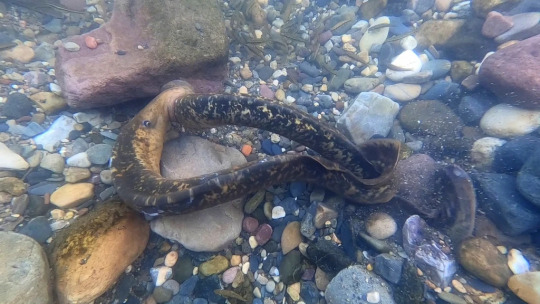
(Image: two lampreys mating. they are coiled onto each other with one using its mouth to suction onto the midsection of the other. They are on a rocky stream bed. End ID)
Lampreys are used in science for several purposes. They are often used as a model organism when attempting to understand the biology of early vertebrates and extinct agnathans. They are also studied quite a bit for their nervous systems. Lamprey brains are very simple and likely represent very early stages of brain development in vertebrates. In addition, they are useful for studies of the transmission of electrical impulses between nerve cells due to their axons (the part of a nerve cell that conducts electricity away from the main body and to other nerve cells), which are large enough for microinjectors to inject test substances into them. Lampreys are capable of fully recovering from having their spinal cords severed, something that is of great interest to surgeons and neurologists. Lampreys have been used as a food source in many cultures around the world. Some species have toxic mucus and blood, requiring them to be cleaned before eating. Historically lampreys have been kept in captivity for use in food as well as other purposes. There are records of people being executed or tortured by being thrown into a pit of carnivorous lampreys. In the wld, carnivorous lampreys generally don't attack humans unless they are starving. In addition, there is a record of one Roman statesman named Lucius Licinius Crassus being scolded for being more upset over the death of his pet lamprey than over the deaths of any of his wives. Unfortunately, the thing a lot of people know lampreys for today is the sea lamprey (Petromyzon marinus) being an invasive species in the great lakes of North America. They have no natural predators in the lakes and feed on a lot of ecologically and commercially important species. Due to their lack of predators, multiple methods are used to try to reduce their numbers and keep them from harming the ecosystem. These include using barriers to keep the adults from migrating upstream to breed, release of targeted poisons called lampricides, and releasing sterilized males into the lakes to mate with the females.

(Image: two sea lampreys suctioned onto a fish. The fish is green and covered with black dots. The two lampreys are suctioned next to each other on the top of the fish's head. Their bodies are dangling off of the fish in different directions. End ID)
#wet beast wednesday#lamprey#sea lamprey#agnatha#agnathan#jawless fish#fish#fishblr#marine biology#freshwater biology#ecology#zoology#animal facts#informative#image described
80 notes
·
View notes
Text
Welcome back to the Paleo Party! This guest is Astraspis!
I love a lil dude who's entire existence is
:00000000000000000000
#video#my art#misc#paleontology#paleoart#fish#agnathan fish#jawless fish#ordovician#astraspis#paleo party
9 notes
·
View notes
Text

A fossilized agnathan head shield of an Ukrainaspis kozlowskii from the Dniester Formation in Nyrkov, Zalishchyky Raion, Ternopil Oblast, Ukraine. Like many similar osteostracans, this jawless fish was originally within the genus Cephalaspis. Osteostracans like Ukrainaspis are armored agnathans or jawless fish that are more closely related to lamprey and hagfish than to bony fish and chondrichthyans. These odd head shields may have been an adaptation against the rise of predatory jawed fish.
#fish#jawless fish#fossils#paleontology#palaeontology#paleo#palaeo#ukrainaspis#osteostraci#agnatha#devonian#paleozoic#prehistoric#science#paleoblr#ウクライナスピス#化石#古生物学
2 notes
·
View notes
Text
i love the merfolk with shark fish-halves, which to me implies that maren ancestors have always had a humanoid top half, but the fish half is less derived the further back in time you go. placoderm maren? AGNATHAN maren??? how far back does it go?
5 notes
·
View notes
Text
Addendum: I suck
I finished yesterday's Woodward Wednesday post in a hurry and made a couple of stupid errors I now need to correct here.
First of all, there is in fact not one but two illustrated pages of Silurian marine life that Alice B. Woodward made for Evolution in the Past, the other one being this one featuring at-least-sort-of fish (which I wrongly stated as only appearing in the Ordovician illustration)
There is actually much to be said of this page, so maybe it's best it be given its own post.

The vaguely sturgeonesque animals at the top are Lasanius, which has recently turned out to be a cyclostome, related to hagfishes and lampreys rather than "proper" fish. Hiding in the background are Lanarkia, and on the sea floor on the left looking oddly like a skate is Thelodus, both thelodont agnathans. In the foreground is Birkenia, an anaspid that isn't even as close to jawed fishes as the thelodonts.
There is also a Tremataspis swimming on the right, looking more like a generic osteotracan than this weird easter egg with a tail ought to (see Nobu Tamura's modern reconstruction below:)

H.R. Giger would tell you this is what a face hugger deposits down your throat, were he still alive.
There's another bulbous weirdo in the illustration: the bottom-dwelling betentacled onion-mimic that looks a bit like some kind of scotoplane. That is no sea cucumber, but a strange nautiloid called Gomphoceras. This thing is so obscure and odd I don't think even Joschua Knüppe has made a reconstruction of it yet. You hear that, Joschua? I'm calling you out!
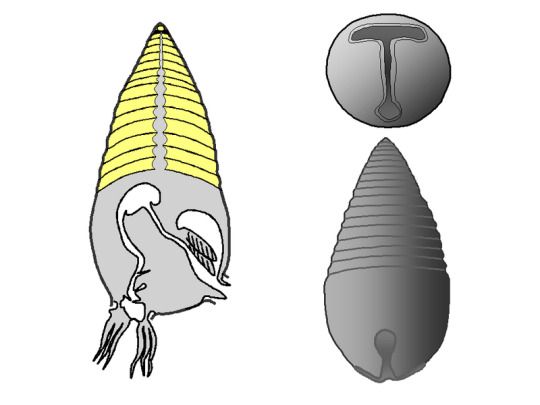
What if Nautilus, but a Mandalorian?
Finally there's that sort of vaguely horseshoe crab -like animal on the bottom, under Gomphoceras. What exactly is that? In the book it's listed as 'Hemiaspis', which is a genus of snake, so a clear case of a preoccupied name. The fossil appears to have been renamed Limuloides, and is now considered a planatergan, a sister group of horseshoe crabs that includes everything from spiders to sea scorpions.

They really aren't kidding when they say horseshoe crabs refuse to change, when their nearest relatives started out looking almost the same and are now spinning webs probably in the very room you are in right now.
#vintage paleoart#paleoartists#silurian#fish#nautiloid#horseshoe crab#jawless fish#errata#Woodward Wednesdays#Paleozoic
0 notes
